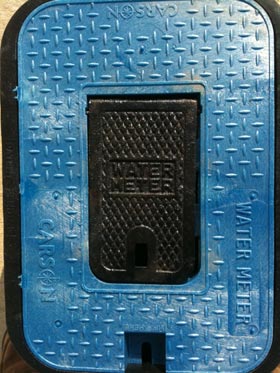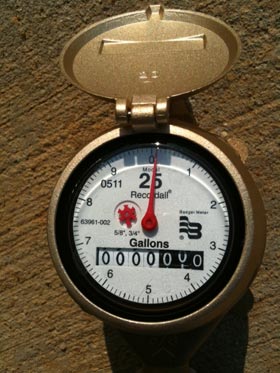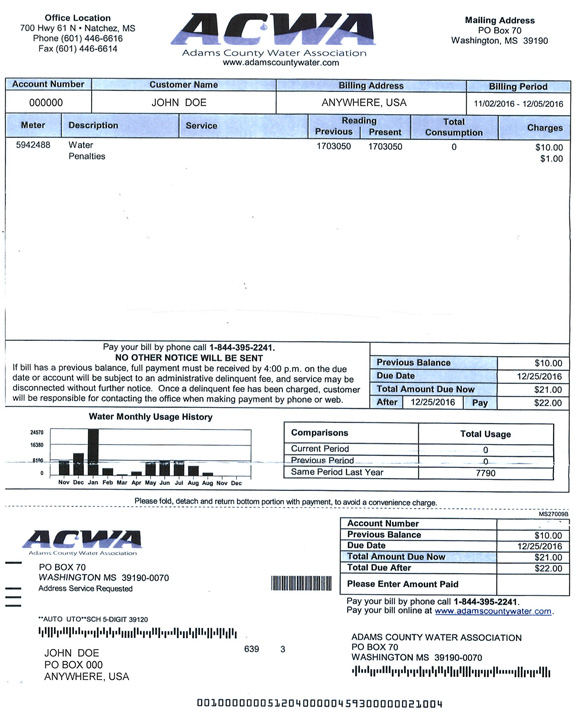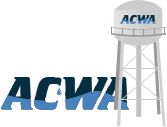Q: What should I do in the event of freezing temperatures?
- The service line from the water meter and the interior plumbing is the homeowner's responsibility.
- Cover outdoor water valves and spigots when temperatures dip below 32 degrees. A fitted plastic cover can be found at most hardware and home improvement stores, but tape and cardboard wrapped around a spigot can be just as effective.
- Wrap exposed water pipes. This insulates them against freezing and helps to prevent water waste by keeping the water in the pipes warmer.
- Invest in a water heater blanket, available at most hardware and home improvement stores. This can also save water and help cut water and heating bills.
- Turn off your irrigation system at the main control and open each valve until the entire system drains of water. After the system is drained, close each valve and leave the system shut off until early spring.
- Open cabinet doors when temperatures dip below 32 degrees to expose pipes to heat.
- Drip the faucet overnight in order to prevent freezing. CAUTION: Even a thin stream of water dripping may cause an increase in your next water bill.
- Install a shut off valve on your side of the meter. You may consider turning off this valve to allow all the water in the pipes to drain out anytime you are leaving the home overnight. CAUTION: The valve inside the meter box is not for customer use.
- Due to the strain on staff during major storm events, the association must charge a fee to turn the water off at the meter.
Q: How do I read my water meter?
A: The meter is usually located on the front of the property and housed in a cast iron or plastic meter box marked WATER. To check the meter, put on gloves, and insert a tool such as a screwdriver in the hole and pry open the cast iron or plastic lid (do not use your fingers!).
The cast iron lid is heavy, so be careful when handling it. Set the lid aside. Before reaching in to the meter box, check carefully for insects or rodents. To read the meter, lift the cover and always replace the cover on your water meter when finished. Reading your water meter is similar to reading the odometer in your car. Read all the numbers from left to right that appear close to the center of the glass window.

Water Meter Box

Water Meter
Q: As a customer, what portion of my water line is my responsibility?
A: The customer is responsible from the water meter to the house. ACWA is responsible from the meter connection on the customer's side of meter box back to the main line.
Q: When will my water meter be disconnected for non-payment?
A: The water service is subject to be disconnected for non-payment any time after the due date shown on the right side of your bill.

Example of the ACWA water bill with important information and due dates highlighted in blue
Q: Why does my water look dirty, have sediment and/or particles in it?
A: Some possible causes of problems with water which appears dirty, has an unusual color, or sediment/particles include:
- Sediments or pipe materials from breaks in water mains or hydrants. Water mains in the distribution system can fail due to age, corrosion, high pressure surges, or damage by construction work. Hydrants can also be broken off by vehicles.
- High flows can occur in water mains due to fire fighting, water system tests, or maintenance. Unusual high-flow conditions can stir up sediment or scale from water mains.
- Construction activities: the customer's service connection from the distribution main to the water meter is sometimes disturbed by construction activities of contractors or other utilities.
- Aging galvanized plumbing: rust particles or scale from galvanized steel home plumbing can also produce reddish-brown water or rust particles, particularly noticeable when a tap is first turned on.
Since there are many causes of dirty water, ACWA investigates each complaint carefully. Please be prepared to answer the following questions when reporting this problem at 1-601-446-6616.
- What is the location of the premises where the dirty water occurred?
- When was the dirty water first detected?
- What does the water look like? Does it have color?
- Are both the cold and hot water dirty?
- Is the water dirty at all faucets?
- Are the particles large, small, or colored; does the water look milky or contain air?
The answers to these questions will assist us in finding the cause of the dirty water and may also suggest corrective steps to take. Our water operators respond to calls regarding water which appears to be dirty, colored or has foreign particles, within one business day.
Q: Why do I sometimes get cloudy water coming out of my faucets?
A: Cloudy water could be a result of dissolved air in the water, which is a common and harmless condition. To verify this, place the cloudy water in a glass and observe whether it clears from the bottom up (you may be left with bubbles on the side of the glass and a small surface layer of bubbles). If this occurs then you have dissolved air in the water.
If the cloudy water persists, or if you are noticing unusual tastes or odors, please call 1-601-446-6616, and give us your address and a telephone number.


















